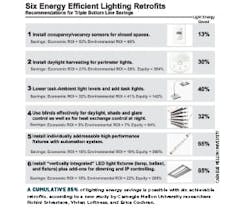6 Lighting Retrofits with Dramatic Benefits
A few cost-effective retrofits can save a staggering 85% of lighting electricity demand, according to the Center for Building Performance and Diagnostics at Carnegie Mellon University.
A new study combines post-occupancy evaluations, lighting controls projects, and published research linking health, productivity, resource conservation, and environmental improvements to high performance building systems. The result: six solutions that reflect first cost, energy and carbon savings, maintenance needs, and human health and performance benefits. The study also aims to quantify the dollar value of reduced emissions and improved health.
Could one of these retrofits make a difference on your energy bill?
1) Closed Space Control
Consider occupancy or vacancy sensors for closed spaces. Conference spaces are occupied 30-70% of the time, while closed offices can be as low as 35%, the researchers say. Areas like kitchens, copy rooms, and bathrooms range as low as 10%.
Because these spaces account for more than 25% of the typical office building, they can incur significant energy costs despite their sporadic use. The team determined that adding vacancy sensors to one-quarter of a baseline building would cost roughly 65 cents per square foot but save 34 cents, offering a two-year payback.
The baseline facility in the study covers 100,000 square feet. Its lighting consumes 6.8 kWh per square foot at 10 cents per kWh annually.
2) Daylight
Harvesting
Daylight sensors that provide on-off or dimming for the first and second rows of lights on the facade ensure savings even without a full automation system.
The researchers recommend combining the sensors ($65 per workstation) with wireless controls and a web-based portal for a total of roughly $190 per workstation. Annual energy savings result in an ROI of 21% and a payback of about five years.
However, many office buildings are capable of daylighting up to 100% of the facility. “Given that, this retrofit measure can save up to 70% of a medium-size office building’s total lighting energy,” the authors wrote. “In deeper section buildings, daylight harvesting can save 10 to 35% of lighting energy.”
3) Task Lighting
U.S. offices frequently exceed 2 watts per square foot with light levels over 500 lux, more than is necessary for most tasks, the team explains. Reduce ceiling lighting by roughly 50% to deliver 200-300 lux and augment with 6-8W LED task lights.
Delamping costs about $32 per employee, while a high-performance LED task light is roughly $164, according to analysis of recorded installations cited in the study.
“Given that less than 50% of office floors are dedicated to individual workstations, and given the shift to predominantly computer-based tasks for which lower ambient lighting levels are preferred, this retrofit measure can save up to 40% of a medium-size office building’s total lighting energy,” the team writes.
4) Blind Management
Venetian blinds are invaluable for glare control and shading. A well-designed and well-managed set of blinds allows adequate daylight without glare and overheating.
A building with existing blinds will pay about 1 cent per square foot or $2 per employee for the increased time investment in blind management, while the first cost for new blinds would be roughly $2.70 per square foot or $540 per employee, the team determined.
A separate Carnegie Mellon study at the DOE’s Energy Efficient Buildings Hub in Philadelphia reveals an ROI of 5% and a payback of 19 years for new blinds, while better managing existing blinds would offer a quicker payback.
5) Smart Ballasts
Though cost-intensive, digitally addressable dimming ballasts with automated control enable FMs to bring lighting power density below 1 watt per square foot and help ensure optimal lighting levels.
The researchers estimate a cost of roughly $630 per employee to install and commission ballasts and an automation system and to train staff on its use. Such a project typically carries an ROI of 15% and has an estimated payback of seven years.
6) Vertically Integrated Fixtures
The most expensive but most effective solution includes installing vertically integrated LED fixtures with dimming and IP control in place of existing troffers housing two to four T12 or T8 lamps. Vertically integrated LEDs combine the lamp, ballast, and fixture as one item.
Costs vary depending on the existing lighting being replaced by the LED fixtures; for example, existing wiring might be adequate for the required data and power connections. Replacing only the lamps also helps keep costs down, coming in at about $2.40 per square foot or $480 per employee. The vertically integrated solution runs roughly $4.50 per square foot or $900 per employee.
However, the potential savings are significant. The DesignLights Consortium found a 40% reduction in lighting energy consumption and a 75% increase in work surface light levels by upgrading fixtures.
To learn more about additional value provided by the environmental and human health benefits of these tips, visit www.eebhub.org.
